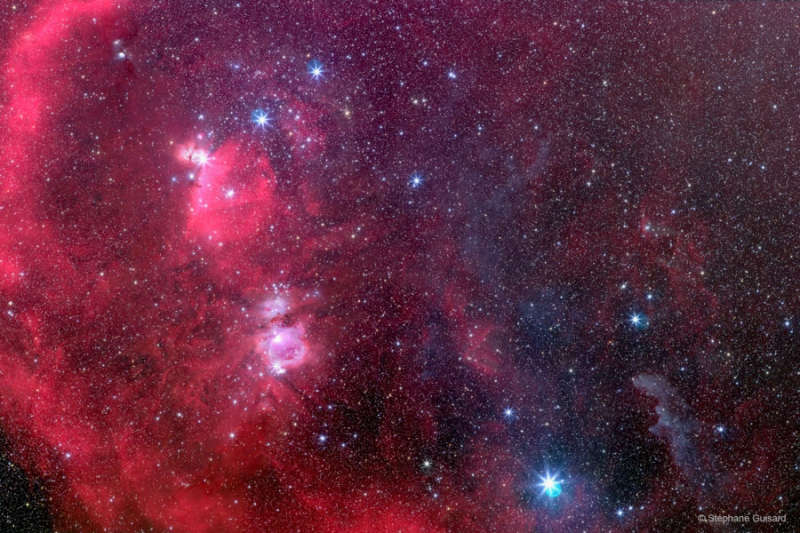Credit & Copyright: StIphane Guisard
Explanation:
Do you recognize the belt of Orion in this image?
The familiar trio of stars,
visible to the unaided eye,
can be found across the upper left.
Otherwise, the southern part of the constellation Orion has taken
on a new look in
this unusually deep and wide view
First note that the lower left belt star,
Alnitak,
illuminates the dusty
reflection
nebula known as M78.
Directly below
Alnitak,
a close inspection will reveal the
Horsehead Nebula.
Farther right and below is the Orion Nebula,
M42,
itself visible to the unaided eye.
The brightest star in the frame, near the bottom right, is
Rigel.
A bright blue star, Rigel illuminates the ominously shaped dust patch known as the
Witch Head Nebula, visible as the
blue reflection nebula near the
lower right corner.
Finally, appearing as a vast red ring and encompassing the entire region, is
Barnard's Loop.
Humans
could see this entire menagerie, unaided, were their eyes
about 10,000 times more sensitive.
1999 2000 2001 2002 2003 2004 2005 2006 2007 2008 2009 2010 2011 2012 2013 2014 2015 2016 2017 2018 2019 2020 2021 2022 2023 2024 2025 |
Yanvar' Fevral' Mart Aprel' Mai Iyun' Iyul' Avgust Sentyabr' Oktyabr' Noyabr' Dekabr' |
NASA Web Site Statements, Warnings, and Disclaimers
NASA Official: Jay Norris. Specific rights apply.
A service of: LHEA at NASA / GSFC
& Michigan Tech. U.
|
Publikacii s klyuchevymi slovami:
Orion - Orion Nebula - Witch Head Nebula - Orion - Tumannost' Oriona - tumannost' Golova Ved'my
Publikacii so slovami: Orion - Orion Nebula - Witch Head Nebula - Orion - Tumannost' Oriona - tumannost' Golova Ved'my | |
Sm. takzhe:
Vse publikacii na tu zhe temu >> | |
